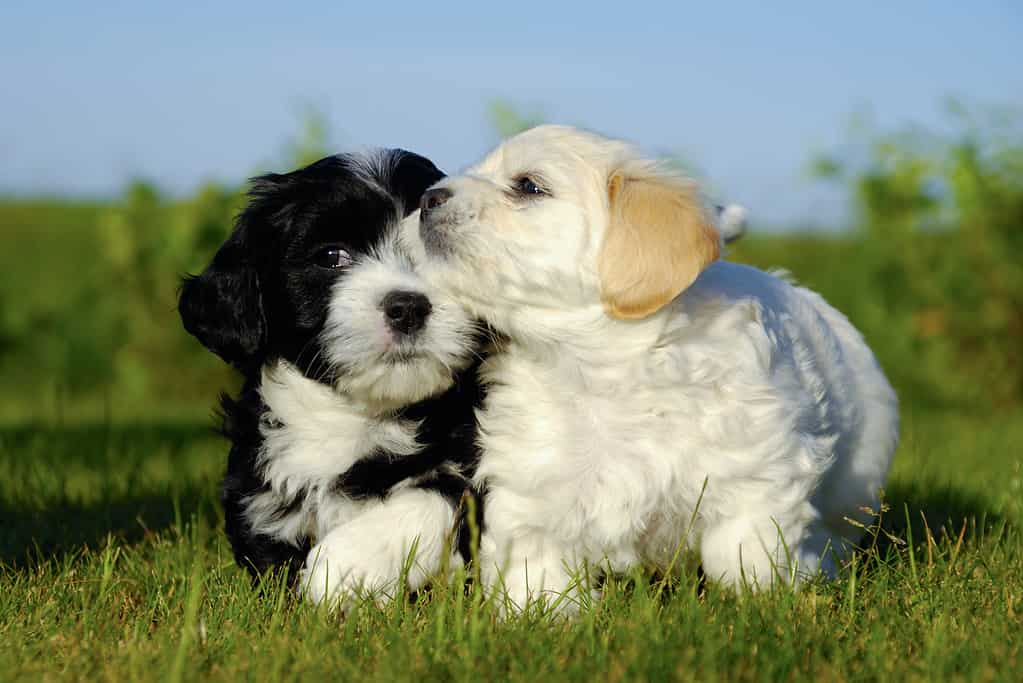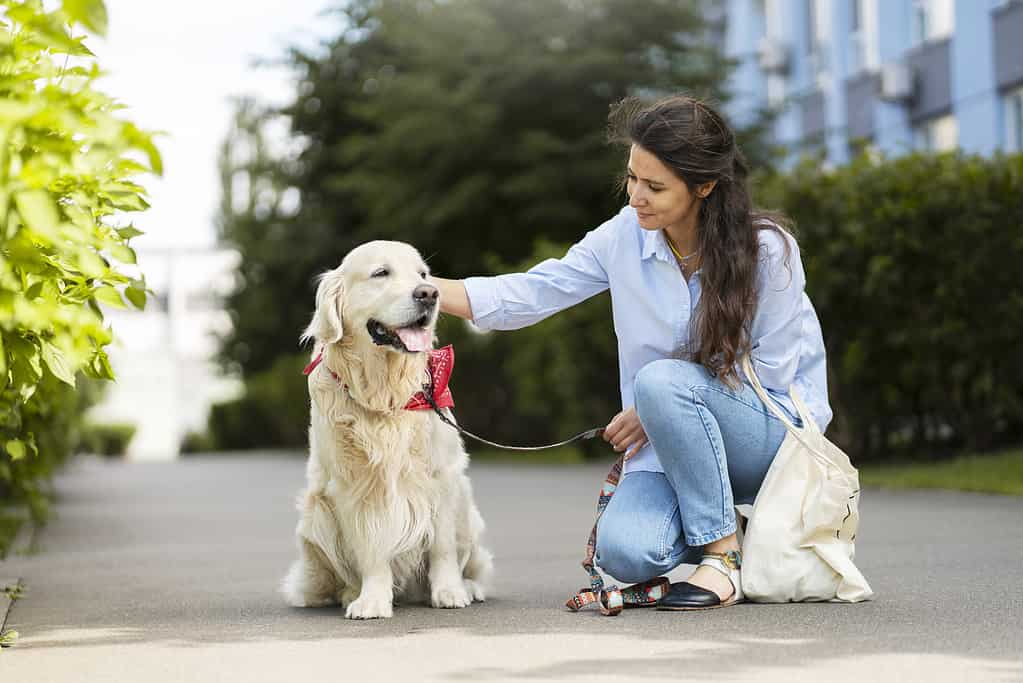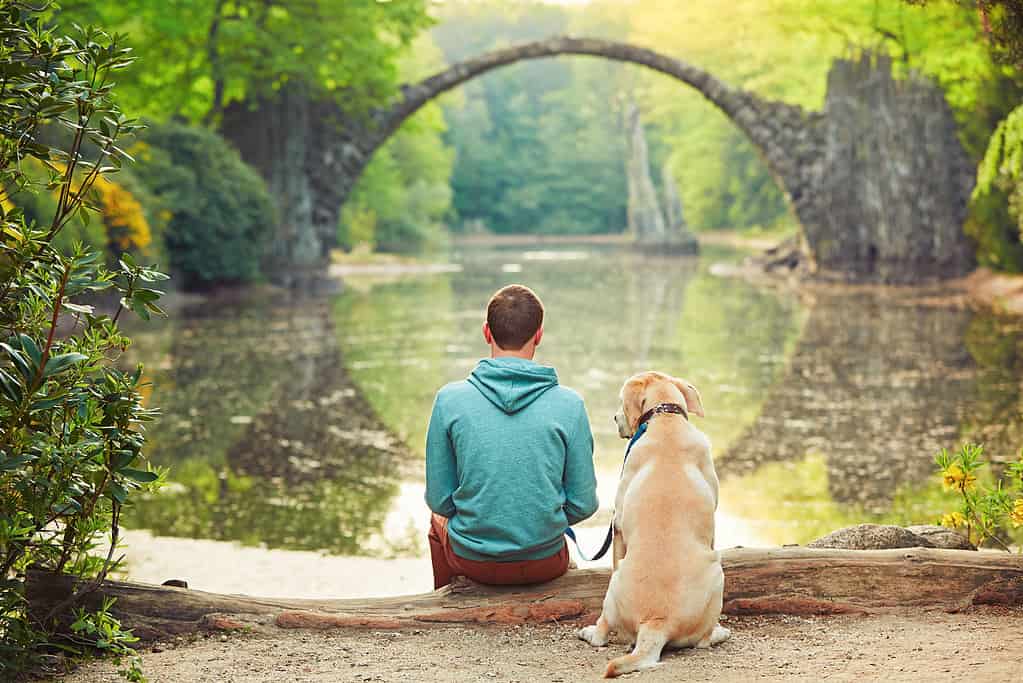If you’re welcoming a new puppy into your home or noticing that your dog is struggling in their interspecies interactions, you may be interested in how to best socialize your canine companion with other dogs.
Socialization describes the process of gently and ethically introducing and supporting positive associations for your dog to various sights, sounds, smells, tastes, textures, and social interactions in their environment. The early socialization period occurs between 3 and 12 weeks of age in dogs, and it represents the most crucial period of socialization for your pooch. During this age, your puppy’s brain is primed to create new neural connections and learn about their environment.
After 12 weeks old, socialization can still occur but it is often a more difficult process and typically requires taking incremental steps and developing a careful plan to avoid overwhelming your dog and creating fear responses. Finally, continued socialization and maintenance of your dog’s comfort in their environment should continue throughout their life. Socialization between dogs is a huge component of supporting the development of a well-adjusted pup.
In this guide, we’ll cover seven crucial tips for socializing your dog with other dogs.
1. Crucial Tips for Socializing Your Dog with Other Dogs: Start Young

It’s crucial to start socializing your puppy as young as possible, balancing vaccination safety with the need for novel interactions with other pups.
©Lars Christensen/iStock via Getty Images
If you are bringing home a puppy under 12 weeks of age, you have the opportunity to socialize your dog with other dogs during the critical early socialization period. During this time, it’s especially important to take advantage of the neuroplasticity of their puppy brain and set up highly positive experiences with other dogs.
It’s important to make sure socialization occurs for these puppies outside of their littermates. While taking vaccination safety into account, you’ll want to introduce them to the sights, sounds, and interactions with novel dogs. If your puppy can’t yet run around in public parks due to not having enough vaccinations, you can still hold them in these environments and support them in social processing. Without directly meeting other dogs, under-vaccinated puppies can still process new sights, sounds, and smells associated with new dogs. According to a position statement by the American Veterinary Society of Animal Behavior, puppy guardians must balance vaccination safety with the importance of early socialization.
2. Make Sure Interactions are Positive

It’s important for successful socialization that novel interactions with other dogs are markedly positive.
©otsphoto/Shutterstock.com
A crucial aspect of socializing your dog with other dogs is to do your best to ensure the interactions are markedly positive. The goal is for your dog’s brain to form positive associations with socializing with other pups. This can’t happen if you force interactions or set meetings up in ways that increase the likelihood of negative experiences.
For example, if you simply plop your puppy into a dog park full of rowdy pooches who all bound over excitedly to greet your pup, they’ll likely feel quite overwhelmed. It’s common to see dogs who are put into overwhelming social interactions try to hide under park benches, between or behind their caregiver’s legs, shut down, or start acting defensively. A better approach would be to take your highly reputable puppy socialization classes, ask a friend if you can introduce your puppy to their dog one-on-one, or take your pup to the dog park during off-hours when there are only a couple of dogs present. If your dog is small or is still a puppy, look for dog parks that offer a small dog section. The goal is to take small enough steps that your dog feels safe, comfortable, and confident in their new social interactions.
3. Crucial Tips for Socializing Your Dog with Other Dogs: Learn Dog Body Language

Learning dog body language will help you assess and adjust the socialization process based on your dog’s comfort level.
©maljalen/iStock via Getty Images
To best set your pup up for success during the socializing process, it’s important to be able to accurately read their body language. The more attuned you are to the emotional state and signals of your pooch, the better you can react and adjust the process according to the comfort level of your dog. You’ll also be able to better assess how socializing with other dogs is going. Check out our article on identifying signs of stress in dogs to learn more.
Body language indicating a positive experience for socializing between dogs includes loose, swingy body movements (as opposed to stiff), non-fixation (no hard staring), and a balanced back-and-forth interaction as opposed to one dog doing all of the chasing during play.
If your dog is signaling discomfort, it’s best to take a step back and assess how to help them feel more comfortable. Maybe they simply need a little more distance or break to sniff and socially process without the pressure of a pooch inches away from them. Or perhaps it’s best to choose a new socializing partner if you are seeing signs that the energy levels of the dogs aren’t well matched.
If your dog is showing acute signs of stress, defensiveness, or being shut down, it’s far better to end the session entirely, remove them from the environment, and come up with a plan to make future interactions more positive. This may include calling in a force-free, qualified canine behaviorist for assistance. Forcing social interaction can become dangerous, damage your dog’s confidence, and will only serve to create negative associations with other dogs and possibly you.
4. Socialize in a Range of Environments

Make sure to socialize your pup in a variety of new environments. Just make sure to not force them to stay in overwhelming spaces.
©suefeldberg/iStock via Getty Images
Whether your dog is a puppy under 12 weeks of age or is past the early socialization period, it’s crucial to practice social skills in a range of environments. Socialization of your dog with other dogs in a variety of settings can include the following:
- Greeting dogs on daily walks.
- Interacting at well-organized dog parks.
- Having play dates at your home- this is crucial for avoiding the development of guarding and possessiveness of the home.
- Having play dates a the other dog’s house.
- Joining puppy socialization classes.
- Joining doggy daycare.
- Take your pup to dog-friendly businesses.
- Going on hikes that often have dogs present.
- Going to dog-friendly beaches.
A note on dog parks: it’s important to choose wisely when searching for a dog park to take your pup to. Some dog parks aren’t well set up and don’t feature environments where caregivers are attentive and responsible in supporting safe interactions. It’s best to visit a dog park on your own first to assess the overall vibe. Look for parks where the culture is based on responsibility and attentiveness (not caregivers staring at their phones while their dogs run around unsupervised), feature safe infrastructure, and ideally have separate sections for large and small dogs. You may not find a suitable dog park in your area, and that’s ok. It’s better to avoid unsuitable dog parks and instead search for better environments to socialize your pup with other dogs.
5. Crucial Tips for Socializing Your Dog with Other Dogs: Socialize Consistently

Consistency is a crucial aspect of socializing your dog with other dogs during the early socialization period and as they reach adulthood.
©iStock.com/Przemysław Iciak
Whether your pup is in the early socialization period or beyond 12 weeks of age, it’s important to socialize with other dogs consistently. The environment and amount of dogs will depend on your dog. For example, a socialization schedule could look like multiple multi-dog play dates per week at the park, your home, and a puppy socialization class. Or, consistent socialization could mean a one-on-one play date with a low-key, social dog and two sessions of social processing at the park without direct contact per week. The key is to understand the social threshold of your unique pup and to not overwhelm them. Socialization progress is subjective based upon the needs of your canine companion and their comfort level.
What you don’t want to do, especially for puppies in the early socialization period, is have them meet a dog once per week and call it good. At this age especially, they need consistent, positive interactions with novel dogs to develop well-rounded social skills. It can feel like a lot of work, but restricting social access during this crucial developmental period can result in your dog not feeling acutely uncomfortable around other dogs as an adult, especially in public. This discomfort can translate into defensiveness, aggression, anxiety, etc.
Stick to a Schedule
Routine is an important aspect of raising a puppy, so try to set up a healthy schedule and stick to it as much as you can. Use your dog’s progress to adjust accordingly. You may find that they are happy with even more social interactions, or the opposite may be true and you may need to decrease the frequency and focus on small, digestible meetings with other pups.
6. Take Incremental Steps with Under-Socialized or Traumatized Adult Dogs

The key to working on socialization with under-socialized or traumatized pups is to move incrementally at your dog’s pace. Let them socially process at a distance in which they feel safe.
©ISvyatkovsky/iStock via Getty Images
If you are working on socialization with an under-socialized or traumatized adult dog, it’s extremely important to take incremental steps. To succeed, you’ll need to move at the pace of your dog’s comfort level. Depending on the intensity of your dog’s sensitivity to other pups, working with a qualified, ethical behaviorist or veterinary behaviorist is an excellent idea.
To support an adult dog who is under-socialized or has had traumatizing experiences with other dogs, you need to understand their threshold for interactions. In this context, threshold refers to the distance and level of interaction your dog can handle before they become overwhelmed. A dog who is over a threshold in an environment may become shut down or highly defensive.
If your dog is frantically barking or fixated and staring at other dogs while out on a walk then they are over the threshold. In this case, you need to back up to a distance in which they can notice the trigger stimulus (in this case, the dog) without becoming over the threshold. It is within this zone of relative comfort while also noticing the dogs that you want to work on developing positive associations. You can use high-value treats to help your dog associate other dogs with something markedly positive. It may take weeks or months to help your dog slowly and incrementally feel comfortable enough to move closer to other pups. The key is to allow them the space they need to feel safe and able to socially process. Use high-value treats to form positive associations with other dogs (classical conditioning).
7. Crucial Tips for Socializing Your Dog With Other Dogs: Manage Your Expectations

It’s important to understand that, just like for humans, dog sociability exists on a spectrum. We need to accept our dogs as individuals and support them as best we can.
©Chalabala/iStock via Getty Images
While everyone wants to raise a pup who’s highly social with other dogs, this simply isn’t going to be the reality with every dog. Even for pups who began socializing young, it’s important to remember that each dog is an individual with a unique genetic history, health, brain chemistry, and early life experiences.
You may find that once your puppy starts maturing they aren’t interested in playing or initiating a lot of social interactions. While it’s important to assess if they need support in socialization, it’s also totally normal if they don’t particularly enjoy other dogs. Rather than trying to force your pup to be super dog-friendly, it’s far better for their emotional and mental well-being to manage your expectations.
Dog Sociability Exists on a Spectrum
We know that people exist on a spectrum of sociability, and dogs do as well. Canine behaviorists and ethical trainers often talk about four categories of dog sociability: dog-social (10%), dog-tolerant (40%), dog-selective (40%), and dog-aggressive (10%). Highly dog-social adult dogs aren’t the norm and generally represent about 10% of the domesticated dog population. Of course, it seems like they’re everywhere because these are the pups who can most easily go out and about, especially if they’re also highly comfortable with people. However, it’s far more common for your dog to be dog-tolerant or dog-selective. These categories tend to make up about 80% of the population of pet dogs.
Where your dog falls on this spectrum will likely change over time and with experiences. Puppies under 6 months of age tend to fall in the dog-social category. As they reach physical maturity, you may notice their sociability changing- this is normal. If your pup is dog-social as an adult, you may notice that they become less so as they become a senior.
Rather than trying to force your adult dog into the 10% category of dog-social, it’s best to have a realistic assessment of your pup’s interactions with other dogs. This isn’t to say that if your dog is highly reactive around other dogs you are doomed to keep them isolated. With the help of a qualified behaviorist and possibly also a veterinary behaviorist, you can set up an ethical, incremental plan to help them ideally feel more comfortable and safe around other dogs. However, this plan needs to be realistic, ethical, non-forceful, and adjustable.
One of the most crucial aspects of socialization is to facilitate safety and comfortability and to accept and love your dog as the complex, individual being they are.
The photo featured at the top of this post is © oneinchpunch/Shutterstock.com
Ready to discover the top 10 cutest dog breeds in the entire world?
How about the fastest dogs, the largest dogs and those that are -- quite frankly -- just the kindest dogs on the planet? Each day, AZ Animals sends out lists just like this to our thousands of email subscribers. And the best part? It's FREE. Join today by entering your email below.
Thank you for reading! Have some feedback for us? Contact the AZ Animals editorial team.







